On Dec. 9, Google’s Quantum AI team unveiled Willow, a cutting-edge quantum computing chip that represents a significant milestone in quantum technology.
Willow features 105 physical qubits and improved error correction, enabling it to handle computations that challenge even the most powerful supercomputers within known timescales in physics. Google emphasized that this development is a step forward in their quest to create reliable quantum computers capable of expanding human knowledge for the benefit of society.
Shortly after the announcement, discussions erupted across the tech and crypto communities, with some claiming that quantum computing chips like Willow could spell the end of Bitcoin and potentially all of cryptocurrency. These concerns stem from the belief that quantum advancements could eventually break the cryptographic algorithms underpinning blockchain technology, threatening its security and viability. In response, prominent figures in the crypto space weighed in to clarify the actual risks and timelines associated with quantum computing and Bitcoin.
Quantum computing introduces a fundamentally different approach to processing information compared to classical computing. Instead of relying on binary bits, which can only exist as 0 or 1, quantum bits (qubits) leverage superposition to exist in multiple states simultaneously. Additionally, qubits can become entangled, allowing quantum computers to process vast amounts of data in parallel and solve complex problems far more efficiently than classical systems.
Google’s announcement highlighted key advancements behind Willow’s development, including their ability to fabricate qubits in-house using superconducting integrated circuits. These circuits utilize carefully selected materials and precise fabrication techniques to create high-quality qubits that are stable and controllable. Noise reduction also plays a crucial role, as quantum computers are highly sensitive to external disturbances such as electromagnetic fields, heat, and cosmic rays. To minimize noise, Google engineers build specialized packaging that shields qubits while maintaining their connectivity to external systems.
Controlling qubits involves delivering microwave signals through specialized wiring systems that can function across extreme temperature gradients, from room temperature to near absolute zero. These systems ensure efficient signal delivery while protecting qubits from noise. Additionally, Willow operates within a dilution refrigerator, an environment colder than outer space. This ultra-cold state is necessary for the superconducting qubits to maintain their quantum properties and perform calculations with minimal energy loss.
A critical distinction in quantum computing is the difference between physical and logical qubits. Physical qubits are the raw units of quantum information used in hardware. However, due to the fragile nature of qubits and their susceptibility to errors from noise and interference, physical qubits alone are not sufficient for reliable computations.
Logical qubits, on the other hand, are error-corrected qubits that combine multiple physical qubits to form a single, stable computational unit. Achieving a reliable logical qubit requires significant overhead; for example, thousands of physical qubits may be needed to construct one logical qubit, depending on the quality of error correction.
This distinction is crucial because the numbers often cited for breaking cryptographic algorithms, such as millions of qubits, refer to physical qubits, of which Willow has only achieved 105, underscoring how far quantum technology still has to go before posing a real threat to encryption systems.
Bitcoin relies on two primary encryption systems. The first is ECDSA 256, or Elliptic Curve Digital Signature Algorithm, which is used for transaction signatures. While ECDSA 256 is theoretically vulnerable to Shor’s algorithm, which can solve certain mathematical problems exponentially faster using a quantum computer, experts agree that breaking this encryption would require millions of logical qubits. Willow’s 105 physical qubits are far from sufficient. The second is SHA-256, or Secure Hash Algorithm, which powers Bitcoin’s proof-of-work mining process. Grover’s algorithm could potentially halve SHA-256’s security, but doing so would also demand millions of physical qubits. The quantum computing industry has not yet approached such a scale.
Charles Edwards expressed concerns about dismissing the rapid advancements in quantum computing (QC), likening current skepticism to the early days of Bitcoin, when many prematurely deemed it valueless. He stressed that quantum computing is not only real but transformative on a massive scale, with the potential to disrupt industries, including Bitcoin’s cryptographic security, if proactive measures are not taken.
Edwards cited studies estimating that the quantum computing threat to Bitcoin’s encryption could materialize within five to ten years. He noted that breaking Bitcoin’s SHA-256 encryption could require as few as 2,500 logical qubits—far fewer than the exaggerated figures like 300 million that some sources suggest. While logical qubits are distinct from physical qubits, he emphasized that error correction technologies are improving exponentially, making this milestone increasingly achievable. Edwards pointed out that many technology development curves follow exponential trends, a pattern already seen with artificial intelligence and now unfolding with quantum computing, which experienced significant breakthroughs in 2024 alone.
He warned that many industry estimates place a serious 50% risk of Bitcoin’s cryptographic vulnerabilities becoming exploitable within five to ten years. Given this trajectory, he urged the Bitcoin and blockchain communities to act swiftly, particularly as leading quantum computing firms listed on the NASDAQ project reaching around 3,000 logical qubits within five years.
Edwards also highlighted the logistical challenges of transitioning Bitcoin to quantum-resistant cryptography. Even under the best-case scenario, he estimated it would take at least one year to implement such upgrades across the network after reaching consensus. This limited lead time underscores the urgency for action now, regardless of whether the quantum threat materializes in three, five, or even fifteen years.
Ben Sigman reiterated that Willow’s 105 physical qubits fall dramatically short of the millions required to threaten Bitcoin. He emphasized the importance of staying vigilant but reassured that Bitcoin’s cryptography remains robust for now.

Featured Image via YouTube









